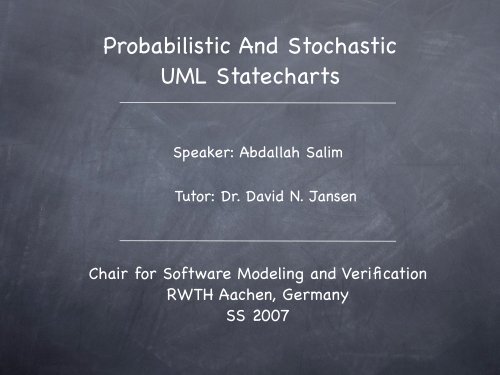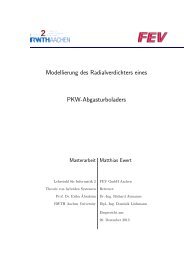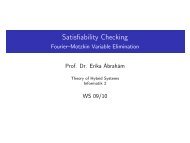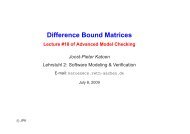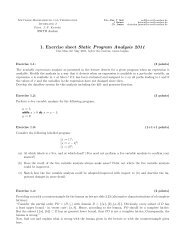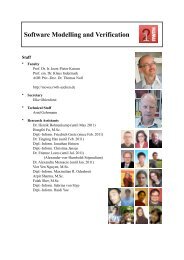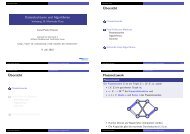Probabilistic And Stochastic UML Statecharts - Software Modeling ...
Probabilistic And Stochastic UML Statecharts - Software Modeling ...
Probabilistic And Stochastic UML Statecharts - Software Modeling ...
Create successful ePaper yourself
Turn your PDF publications into a flip-book with our unique Google optimized e-Paper software.
<strong>Probabilistic</strong> <strong>And</strong> <strong>Stochastic</strong><br />
<strong>UML</strong> <strong>Statecharts</strong><br />
Speaker: Abdallah Salim<br />
Tutor: Dr. David N. Jansen<br />
Chair for <strong>Software</strong> <strong>Modeling</strong> and Verification<br />
RWTH Aachen, Germany<br />
SS 2007
Overview<br />
An introduction to <strong>Statecharts</strong><br />
StoCharts<br />
Syntax<br />
Semantics<br />
Case Study: A Beverages dispenser<br />
Conclusion<br />
2
The <strong>UML</strong> perspective - A scenario<br />
Name: Mr Troy aka Mr T<br />
Age: 29<br />
Position: <strong>Software</strong> Engineer<br />
T<br />
T seems to have an idea !<br />
3<br />
Name: Mr McNamara aka Mr M<br />
Age: 27<br />
Position: Visual designer<br />
M
The <strong>UML</strong> perspective - Getting the message across<br />
Mr. T has a great<br />
design idea<br />
What do<br />
you think<br />
M ?<br />
T M<br />
***<br />
but ...<br />
4<br />
Mr. M doesn’t seem to<br />
understand T’s design<br />
What is<br />
that T ?
Mr. T has an idea in<br />
his head<br />
***<br />
The <strong>UML</strong> perspective - The Problem<br />
T<br />
***<br />
but ...<br />
5<br />
Mr. M forms a<br />
completely different<br />
one in his head<br />
M<br />
ooo<br />
This is ...<br />
NOT good
Mr. T redesigns with<br />
<strong>UML</strong>....<br />
<strong>UML</strong><br />
The <strong>UML</strong> perspective - Enter <strong>UML</strong><br />
T<br />
Ok what<br />
about this ?<br />
<strong>UML</strong><br />
Why does Mr M get<br />
it ?<br />
<strong>UML</strong> provides a<br />
Lingua franca that<br />
promotes<br />
communication<br />
between designers<br />
Lingua franca =<br />
Common Language<br />
6<br />
I see it<br />
now !<br />
Mr. M gets it !!!<br />
M<br />
<strong>UML</strong>
Introducing StoCharts - An Intuition<br />
StoChart Example: 6 wins the game<br />
5/6 / player.not six<br />
Rolling<br />
End of roll<br />
P<br />
Won<br />
after(EXP[3sec])<br />
/ player.stop rolling<br />
1/6 / player.six<br />
7<br />
(1) Dice starts rolling<br />
(takes some time to stop:<br />
3 sec)<br />
(2) Nondeterministic choice<br />
- Dice cannot be read<br />
- Dice can be read<br />
(3) <strong>Probabilistic</strong> choice<br />
- {1,2,3,4,5} face-up<br />
(start rolling again)<br />
- 6 face-up<br />
(game over)<br />
⊥<br />
: No need to wait to take edge
=><br />
Some Distinctions - <strong>Probabilistic</strong> choice<br />
(Example: Throwing a fair coin)<br />
<strong>Probabilistic</strong> choice:<br />
It is not clear which possibility out of a discrete set a<br />
system may take.<br />
So what does “not clear” mean ?<br />
- Prediction: 50% of the time heads/tails will<br />
occur.<br />
- BUT impossible to predict the actual outcome for<br />
each toss i.e., whether it’s a head or a tail.<br />
8
=><br />
Some Distinctions - <strong>Stochastic</strong> timing<br />
(Example: Video Streaming)<br />
Client<br />
Video displayed<br />
Video request<br />
Stream<br />
buffered<br />
<strong>Stochastic</strong> timing ?<br />
- Some time needed to schedule video packets (server).<br />
- Some time for video to be displayed (client).<br />
9<br />
Webserver<br />
Scheduling of video<br />
packets
Some Distinctions - <strong>Probabilistic</strong> vs (non)<br />
deterministic Phenomena<br />
<strong>Probabilistic</strong> (Examples: Weather predictions - Probability of<br />
rain, snow etc; Rolling of dice in a board game)<br />
Deterministic (Example: Forced moves in chess)<br />
Nondeterministic (Examples: Free moves in chess and Tic Tac<br />
Toe)<br />
10
Some Distinctions - Non/Not determinism<br />
Nondeterministic Not determinstic<br />
Not deterministic Phenomena<br />
Only infers that a phenomenon is either probabilistic or<br />
nondeterministic (and nothing more !!)<br />
An unfortunate terminology but<br />
one we have to live with :-(<br />
11
Some Distinctions - System vs Environment randomness<br />
Environment randomness<br />
Environment randomness (Example: Reactive system - Bank<br />
ATM, Dispenser, etc)<br />
Intuition: System exposed to external random stimuli and<br />
reacts.<br />
System reaction is NOT random<br />
12
Some Distinctions - System randomness<br />
Requirement : Modems must transmit on different frequencies<br />
modem 1 modem 2<br />
Notation:<br />
- Hj : “Heads” for modem j (1
Overview<br />
An introduction to <strong>Statecharts</strong><br />
StoCharts<br />
Syntax<br />
Semantics<br />
Case Study: A Beverages dispenser<br />
Conclusion<br />
14
=><br />
=><br />
<strong>UML</strong> Extensions - P-<strong>Statecharts</strong> & StoCharts<br />
We can extend <strong>UML</strong> <strong>Statecharts</strong>: 2 fold Extension<br />
Extension 1: <strong>Probabilistic</strong> choice<br />
(Example: Heads/Tails choice on a coin toss)<br />
Extension 2: <strong>Stochastic</strong> timing<br />
(Example: Timing in a Drink dispenser)<br />
<strong>Statecharts</strong> + Extension 1<br />
= <strong>Probabilistic</strong> <strong>Statecharts</strong> (aka P-<strong>Statecharts</strong>)<br />
<strong>Statecharts</strong> + Extension 1 + Extension 2<br />
= <strong>Stochastic</strong> <strong>Statecharts</strong> (aka StoCharts)<br />
15
<strong>UML</strong> Extensions - Random probability<br />
distributions<br />
DET [x min]<br />
A deterministic distribution with a duration of x minutes<br />
EXP [x min]<br />
A negative exponential distribution with a mean of x minutes<br />
UNIF [x min, y min]<br />
A uniform distribution in the interval from x to y minutes<br />
16
1.00<br />
0.75<br />
0.50<br />
0.25<br />
0<br />
<strong>UML</strong> Extensions - Random probability<br />
Prob. DET[5min]<br />
Discrete<br />
function<br />
0 1 2 3 4 5 6 7 8 9 10 11 12<br />
Prob.<br />
1.00<br />
0.75<br />
0.50<br />
0.25<br />
0<br />
Time [min]<br />
17<br />
Prob.<br />
1.00<br />
0.75<br />
0.50<br />
0.25<br />
0<br />
UNIF[5min,10min]<br />
0 1 2 3 4 5 6 7 8 9 10 11 12<br />
EXP[1min]<br />
0 1 2 3 4 5 6 7 8 9 10 11 12<br />
Time [min]<br />
Time [min]
<strong>UML</strong> Extensions - Statechart relations<br />
In a nutshell ...<br />
<strong>UML</strong> <strong>Statecharts</strong> are<br />
trivial P-<strong>Statecharts</strong><br />
<strong>UML</strong> <strong>Statecharts</strong> +<br />
<strong>Probabilistic</strong> choice =><br />
P-<strong>Statecharts</strong><br />
StoCharts<br />
P-<strong>Statecharts</strong><br />
<strong>UML</strong><br />
<strong>Statecharts</strong><br />
18<br />
<strong>UML</strong> <strong>Statecharts</strong> are<br />
trivial StoCharts<br />
P-<strong>Statecharts</strong> +<br />
<strong>Stochastic</strong> timing =><br />
StoCharts
Overview<br />
An introduction to <strong>Statecharts</strong><br />
StoCharts<br />
Syntax<br />
Semantics<br />
Case Study: A Beverages dispenser<br />
Conclusion<br />
19
A syntactical perspective - StoChart drawing<br />
Nodes<br />
C<br />
A<br />
B A<br />
Parent node C encloses its<br />
children A, B<br />
(Default node: A)<br />
20<br />
A C<br />
B E D<br />
F (AND) node partitioned by (OR)<br />
children A and C<br />
(Default nodes: B,D)<br />
F
A syntactical perspective - StoChart drawing<br />
Trivial P-edges<br />
X e[g]/A Y<br />
Verifying<br />
User<br />
X : Set of source nodes<br />
Y : set of target nodes<br />
e : event<br />
g : guard<br />
A : action set<br />
Here: Actions “A” have the form (send) j.e (send event e to the<br />
external component identified by j)<br />
Example (Router Login)<br />
Check password[password=”admin”]<br />
/User.Logged in<br />
21<br />
Showing<br />
Admin Page
A syntactical perspective - StoChart drawing<br />
Non trivial P-edges<br />
e[g]/<br />
X P<br />
Example (File downloading)<br />
Checking<br />
origin<br />
p/A<br />
Check country/<br />
.<br />
.<br />
.<br />
22<br />
R<br />
p’/A S p=p’ is also possible<br />
0.4/downloader.UK<br />
servers available<br />
P<br />
0.6/<br />
downloader.USA<br />
servers available<br />
X : Set of source nodes<br />
Y : set of target nodes<br />
e : event<br />
g : guard<br />
A : action set<br />
p,p’: Probabilities<br />
Showing<br />
UK<br />
Server 1<br />
Showing<br />
USA Server<br />
7
A syntactical perspective - System Perspective<br />
- Intuition: A system is a finite collection of<br />
intercommunicating StoCharts<br />
- Formally: Denotable by the set seen below.<br />
{SC i |1 ≤ i ≤ n,n ∈N}<br />
23
StoChart 4-Tuple<br />
Nodes i<br />
Events i<br />
Vars i<br />
PEdges i<br />
A syntactical perspective - StoChart<br />
SC i = (Nodes i,Events i,Vars i,PEdges i )<br />
A finite set of nodes structured in a tree<br />
A finite set of events<br />
A finite set of local variables<br />
A finite set of P-edges<br />
24
A syntactical perspective - StoChart Events<br />
SC i = (Nodes i,Events i,Vars i,PEdges i )<br />
A finite set of events (Signals that may trigger a state transition)<br />
pseudo event after(F) - stochastic random delays<br />
⊥∉Events i<br />
PSEvents i<br />
No event is required to trigger a P-edge<br />
Set of Pseudo events<br />
25
A syntactical perspective - StoChart Variables<br />
SC i = (Nodes i,Events i,Vars i,PEdges i )<br />
- Intuition: A finite set of local variables with an initial<br />
value that assigns initial values to variables<br />
- Formally: Denotable by the function below<br />
V 0 :Vars i → Z<br />
26
A syntactical perspective - StoChart P-edges<br />
P-edge 4-Tuple (X,e, g, P)<br />
A finite set of P-edges<br />
X ⊆ Nodes i<br />
e ∈Events i ∪ PSEvents i ∪ {⊥}<br />
g ∈Guards i<br />
A non-empty set of source state nodes<br />
27<br />
Triggering event that occurs<br />
A guard existing on the edge<br />
P denotes the possible actions and target state nodes (formal<br />
description needed)
A syntactical perspective - StoChart P-edges<br />
A formal description of P<br />
(X,e, g, P)<br />
P can be formally described by a probability measure in a discrete<br />
probability space<br />
Pow<br />
(Pow(Actions i ) × (Pow(Nodes i ) − {∅}), P)<br />
: Denotes a Power set<br />
28<br />
Ω<br />
Denoting the set of possible outcomes
A syntactical perspective - StoChart scopes<br />
Intuition: The scope of a P-edge is the smallest (in the parent-child<br />
hierarchy) OR-node containing both the source nodes and the target<br />
nodes<br />
H<br />
F<br />
E D<br />
A B<br />
C<br />
G<br />
29<br />
Scope(A->H) = root<br />
Scope(A->D) = G<br />
Scope(A->B) = C
Overview<br />
An introduction to <strong>Statecharts</strong><br />
StoCharts<br />
Syntax<br />
Semantics<br />
Case Study: A Beverages dispenser<br />
Conclusion<br />
30
IOSA 7-Tuple (L,l 0 ,T , A, I,O,Δ)<br />
L<br />
T<br />
A<br />
A semantical perspective - Automaton approach<br />
I<br />
O<br />
Δ<br />
A set L of locations with an initial location<br />
A set of timers (each possessing a cdf)<br />
An input transition relation<br />
A probabilistic output transition<br />
relation<br />
A delay transition relation<br />
31<br />
IOSA =<br />
<strong>Stochastic</strong> I/O-<br />
Automaton<br />
l 0 ∈L<br />
A set of actions partitioned into input-actions<br />
(from external environment) and output-actions (system intrinsic)
A semantical perspective - Automaton approach<br />
IOSA 7-Tuple (L,l 0 ,T , A, I,O,Δ)<br />
I<br />
An input transition relation<br />
I : L × A in → L<br />
32
A semantical perspective - Automaton approach<br />
IOSA 7-Tuple (L,l 0 ,T , A, I,O,Δ)<br />
O A probabilistic output transition relation<br />
O ⊆ L × P(A out × Pow(T ) × L)<br />
33
A semantical perspective - Automaton approach<br />
IOSA 7-Tuple (L,l 0 ,T , A, I,O,Δ)<br />
Δ<br />
A delay transition relation<br />
Δ ⊆ L × T × L<br />
34
A semantical perspective - Enabled Transitions<br />
IOSA 7-Tuple<br />
Transition<br />
o<br />
i<br />
d<br />
(L,l 0 ,T , A, I,O,Δ)<br />
35<br />
Enabled<br />
Always<br />
Only if Input action present<br />
(Input enabledness)<br />
Only if<br />
timer expires (reaches zero)<br />
o: output transition<br />
i: input transition<br />
d: delay transition
ATM request<br />
allow or deny<br />
withdraw<br />
A semantical perspective - IOSA example<br />
-> i<br />
i<br />
Bank<br />
o: output transition, i: input transition<br />
d: delay transition<br />
output transitions always enabled !<br />
input transition enabled<br />
i:request<br />
Idle<br />
i<br />
:request<br />
timer set timer has expired<br />
1<br />
Preparing o: set t Checking d:t<br />
Check<br />
t<br />
to check<br />
finished<br />
timeout ?<br />
i:withdraw<br />
i:withdraw<br />
Error<br />
i:withdraw<br />
i:withdraw<br />
o:<br />
No withdraw without<br />
positive verification !<br />
i:withdraw<br />
36<br />
Bank behavior being modeled !<br />
0.02, deny<br />
<strong>Probabilistic</strong> choice<br />
0.98, allow<br />
Check<br />
positive
Overview<br />
An introduction to <strong>Statecharts</strong><br />
StoCharts<br />
QoS Extensions<br />
Syntax<br />
Semantics<br />
Case Study: A Beverages dispenser<br />
Conclusion<br />
37
How does it work ?<br />
Drinks offered ?<br />
“Espresso” coffee and<br />
“oolong” tea.<br />
Payment ?<br />
A beverage dispenser - Intuition<br />
Money chips - 1 Chip<br />
per drink.<br />
38
A beverage dispenser - <strong>Modeling</strong> perspective<br />
What are we modeling ?<br />
The behavior of the system (system randomness), as seen<br />
by the customer.<br />
What we are not modeling<br />
The expected/desired behavior of the customer<br />
(environmental randomness) is NOT being considered here.<br />
39
A naive <strong>UML</strong> Statechart - Events<br />
Events are sent from the<br />
customer to the HBD.<br />
insert chip.<br />
select espresso.<br />
select oolong.<br />
HBD = Hot Beverages Dispenser<br />
40
select Espresso/<br />
customer.brew<br />
espresso<br />
A naive <strong>UML</strong> Statechart - Closer look<br />
Waiting<br />
for chip<br />
insert chip/<br />
Waiting<br />
for beverage selection<br />
HBD - Hot<br />
Beverages<br />
Dispenser<br />
select Oolong/<br />
customer.brew<br />
oolong<br />
41<br />
insert chip/:<br />
Intuition: In the event of a<br />
chip being inserted, the<br />
system evolves to its next<br />
state<br />
select oolong/customer.brew<br />
oolong:<br />
Intuition: In the event that<br />
oolong is selected, send the<br />
event “brew oolong” to the<br />
customer<br />
Analog for espresso
An improved <strong>UML</strong> Statechart - Closer look<br />
What’s wrong with our naive design ?<br />
Incomplete - Drinking<br />
what we paid for ?<br />
Completing the model<br />
“Placing” of cups in<br />
cup holder<br />
“Filling” of the cups<br />
“waiting” for<br />
someone (not a<br />
system) to remove<br />
the cup<br />
42<br />
remove cup/<br />
select Espresso/<br />
customer.brew<br />
espresso<br />
Filling cup<br />
with espresso<br />
cup full/customer.<br />
notify drink ready<br />
Waiting<br />
for chip<br />
Placing cup<br />
insert chip/<br />
Waiting for cup<br />
to be removed<br />
Improved<br />
HBD (IHBD)<br />
select Oolong/<br />
customer.brew<br />
oolong<br />
Filling cup<br />
with oolong<br />
cup full/customer.<br />
notify drink ready
Extending <strong>UML</strong> <strong>Statecharts</strong> - <strong>UML</strong> Limitations<br />
Limitations of the IHBD<br />
<strong>Modeling</strong> system<br />
requirements ?<br />
(1) No cups => coin<br />
returned to customer<br />
(2) Return a chip<br />
exactly after 10 seconds<br />
(“timeout”)<br />
(3) Brewing takes about<br />
5 seconds (“timeout”)<br />
Realisation: Impossible to model our<br />
requirements without extensions !!!<br />
43<br />
remove cup/<br />
select Espresso/<br />
customer.brew<br />
espresso<br />
Filling cup<br />
with espresso<br />
cup full/customer.<br />
notify drink ready<br />
Waiting<br />
for chip<br />
Placing cup<br />
insert chip/<br />
Waiting for cup<br />
to be removed<br />
Improved<br />
HBD (IHBD)<br />
select Oolong/<br />
customer.brew<br />
oolong<br />
Filling cup<br />
with oolong<br />
cup full/customer.<br />
notify drink ready
Extending <strong>UML</strong> <strong>Statecharts</strong> - <strong>Modeling</strong> requirements<br />
Requirements to be modeled<br />
(1) No cups => coin returned<br />
to customer<br />
(2) Return a chip exactly<br />
after 10 seconds<br />
(“timeout”)<br />
(3) Brewing takes about 5<br />
seconds (“timeout”)<br />
44<br />
1<br />
2<br />
3<br />
IHBD extended<br />
(probabilistic choice &<br />
stochastic timing)<br />
“<strong>Probabilistic</strong> choice”<br />
Enough cups vs not enough cups<br />
“<strong>Stochastic</strong> timing”<br />
after(DET [10s] ) /<br />
customer.return chip<br />
“<strong>Stochastic</strong> timing”<br />
after(EXP [5s] ) /<br />
customer.notify drink ready
Extending <strong>UML</strong> <strong>Statecharts</strong> - Birth of a StoChart<br />
Requirements to be modeled<br />
(1) No cups => coin<br />
returned to customer<br />
(2) Return a chip<br />
exactly after 10<br />
seconds (“timeout”)<br />
(3) Brewing takes<br />
about 5 seconds<br />
(“timeout”)<br />
(1)<br />
(2)<br />
(3)<br />
45<br />
<strong>Stochastic</strong> IHBD (S-IHBD)<br />
select Espresso/<br />
customer.brew<br />
espresso<br />
0.8/<br />
Filling cup<br />
with espresso<br />
after (EXP[5 s])/<br />
customer.<br />
notify drink ready<br />
Waiting<br />
for chip<br />
Placing cup<br />
insert chip/<br />
Waiting for cup<br />
to be removed<br />
0.2/<br />
P<br />
Out of cups<br />
after(DET[10s] /<br />
customer.return chip<br />
select Oolong/<br />
customer.brew<br />
oolong<br />
Filling cup<br />
with oolong<br />
after (EXP[5 s])/<br />
customer.<br />
notify drink ready<br />
remove cup/<br />
insert chip/<br />
customer.return chip
emove cup/<br />
Extending <strong>UML</strong> <strong>Statecharts</strong> - <strong>Statecharts</strong> compared<br />
select Espresso/<br />
customer.brew<br />
espresso<br />
Filling cup<br />
with espresso<br />
Waiting<br />
for chip<br />
Placing cup<br />
insert chip/<br />
cup full/customer.<br />
notify drink ready<br />
Waiting for cup<br />
to be removed<br />
select Oolong/<br />
customer.brew<br />
oolong<br />
Filling cup<br />
with oolong<br />
IHBD - without extensions.<br />
<strong>Modeling</strong> requirements<br />
involving <strong>Stochastic</strong> behavior<br />
not possible !<br />
<strong>Probabilistic</strong><br />
choice<br />
46<br />
select Espresso/<br />
customer.brew<br />
espresso<br />
0.8/<br />
Filling cup<br />
with espresso<br />
after (EXP[5 s])/<br />
customer.<br />
notify drink ready<br />
Waiting<br />
for chip<br />
Placing cup<br />
insert chip/<br />
Waiting for cup<br />
to be removed<br />
0.2/<br />
P<br />
Out of cups<br />
after(DET[10s] /<br />
customer.return chip<br />
select Oolong/<br />
customer.brew<br />
oolong<br />
Filling cup<br />
with oolong<br />
after (EXP[5 s])/<br />
customer.<br />
notify drink ready<br />
remove cup/<br />
insert chip/<br />
customer.return chip<br />
<strong>Stochastic</strong><br />
timing<br />
S-IHBD (IHBD with<br />
extensions).<br />
<strong>Modeling</strong> requirements<br />
involving <strong>Stochastic</strong> behavior<br />
now becomes possible !!
Overview<br />
An introduction to <strong>Statecharts</strong><br />
StoCharts<br />
QoS Extensions<br />
Syntax<br />
Semantics<br />
Case Study: A Beverages dispenser<br />
Conclusion<br />
47
What have we learnt ?<br />
- Awareness of real <strong>UML</strong> limitations and the need to extend them.<br />
- Extending <strong>UML</strong> <strong>Statecharts</strong> with :<br />
- <strong>Probabilistic</strong> choice (P-<strong>Statecharts</strong>).<br />
- <strong>Stochastic</strong> timing (StoCharts).<br />
- Informal and formal syntax of StoCharts ( with examples ).<br />
- Informal semantics : <strong>Stochastic</strong> Input/Output Automata (IOSA).<br />
- Application of <strong>UML</strong> extensions: Case study of beverage dispenser.<br />
48
Some useful reading<br />
Martin Fowler. <strong>UML</strong> Distilled: A Brief Guide to the<br />
standard Object <strong>Modeling</strong> Language, Third edition.<br />
Addison-Wesley Professional, 3rd edition, 2003.<br />
David N. Jansen. Extensions of <strong>Statecharts</strong> with<br />
Probability, Time, and <strong>Stochastic</strong> Timing. PhD thesis,<br />
Universiteit Twente, Bern, 2003.<br />
Scott Kim. Interdisciplinary cooperation. In Brenda Laurel,<br />
editor, the Art of Human Computer Interface Design,<br />
pages 31-44, Addison Wesley, 1990.<br />
49
Thank you<br />
for your attention !


